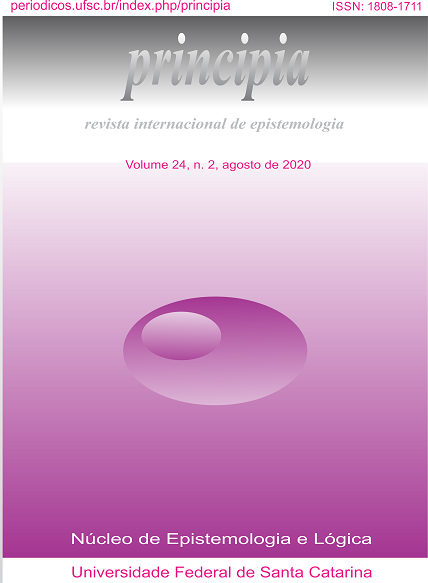Acerca del estatuto ontológico de los fonones
DOI:
https://doi.org/10.5007/1808-1711.2020v24n2p391Abstract
Usually, a solid is conceived as a network of atoms that can vibrate around its equilibrium position generating propagating waves. However, the fact that the energy of these waves is quantized suggests an analogy with the electromagnetic field; then, the quantum “particle” called phonon is defined. In this work we study the relation between the description levels of phonons and of atoms as a case of intra-theoretical relationship.
References
Amann, A.1992. “Must a molecule have a shape?” South African Journal of Chemistry 45: 29-38.
Ashcroft, N. W. y Mermin, N. D. 1976. Solid State Physics, Harcourt College Publishers: Orlando.
Bishop, R. 2005. “Patching physics and chemistry together.” Philosophy of Science 72: 716-722.
Born, M. y Oppenheimer, J. 1927. “Zur Quantentheorie der Molekeln”. Annalen der Physik, 84: 457-484. Versión en castellano en http://www.accefyn.org.co/revista/Vol_22/84/375-391.pdf
Ballentine, L. E. 1990. Quantum Mechanics, New York: Prentice Hall.
Best, N. W. 2016. “Lavoisier's 'Reflections on Phlogiston' II: On the Nature of Heat”, Foundations of Chemistry 18: 3-13.
Carnap, R. 1950. “Empiricism, Semantics, and Ontology”, Revue Internationale de Philosophie 4: 20-40. Reprinted in the Supplement to Meaning and Necessity: A Study in Semantics and Modal Logic, enlarged edition, University of Chicago Press, 1956.
Cartwright, N.1994. “The metaphysics of the disunified world”. Proceedings of the Biennial Meeting of the Philosophy of Science Association, vol. 2: 357-364.
Cartwright, N. 1999. The dappled world: A study of the boundaries of science. Cambridge: CUP.
Chakravartty, A. 2011. “Scientific realism and ontological relativity”. The Monist 94: 157-180.
Chang, H. 2012. Is Water H2O? Evidence, Realism and Pluralism, Dordrecht: Springer.
Dupré, J. 1993. The Disorder of Things: Metaphysical Foundations of the Disunity of Science, Cambridge MA: HUP.
Franklin, A. y Eleanor Knox. 2018. “EmergenceWithout Limits: The Case of Phonons”, PhilSci-Archive: Preprints in Philosophy of Science , http://philsci-archive.pitt.edu/13397.
Hendry, R. F. 1998. “Models and approximation in Quantum Chemistry”, Poznan Studies in the Philosophy of Science and the Humanities 63:123- 142.
Hendry, R. F. 2010.“Ontological Reduction and Molecular Structure”, Studies in History and Philosophy of Science Part B: Studies in History and Philosophy of Modern Physics 41 no. 2: 183-91.
Hettema, H. 2012. Reducing Chemistry to Physics. Limits, Models, Consequences, Groningen: Rijksuniversiteit Groningen.
Kittel, C. 1998. Introducción a la física del estado sólido, Reverté: Barcelona.
Kong, Y., Dolgov, O. V., Jepsen, O. and Andersen, O. K. 2001. “Electron-phonon interaction in the normal and superconducting states of MgB2” Physical Review B 64, 020501.
Labarca, M. y Lombardi, O. 2010. “Why orbitals do not exist?” Foundations of Chemistry 12: 149-157.
Ladyman, J. 2015. “Are there Individuals in Physics, and If So, What Are They?”, in Guay, A. and Pradeu, T. (eds.) Individuals across the Sciences, Oxford University Press.
Lombardi, O. y Labarca, M. 2005. “The ontological autonomy of the chemical world” Foundations of Chemistry 7:125-148.
Lombardi, O. y Pérez Ransanz, A. R. 2012. Los Múltiples Mundos de la Ciencia. Un Realismo Pluralista y su Aplicación a la Filosofía de la Física, México: UNAM-Siglo XXI.
Lombardi, O. 2014. “Linking chemistry with physics: arguments and counterarguments” Foundations of Chemistry 16: 181-192.
Sakurai, J. J. 1994. Modern Quantum Mechanics, Revised Edition, Addison-Wesley: New York.
Scerri, E. 2000. “The failure of reduction and how to resist disunity of the sciences in the context of chemical education”. Science & Education, 9: 405-425.
Scerri, E. R. 2011. “Editorial 37.” Foundations of Chemistry 13: 1-7.
Scerri, E. R. 2012. “Top-down causation regarding the chemistry-physics interface: a sceptical view.” Interface Focus 2: 20-25.
Scerri, E. R. 2013. “Philosophy of chemistry: where has it been and where is it going.” Pp. 208-225, in J.-P. Llored (ed.), The Philosophy of Chemistry: Practices, Methodologies, and Concepts. Newcastle: Cambridge Scholars Publishing.
Shinen, N. S. 1963. “Nonlinear acoustic interaction in MgO at 9 Gc/sec”, Physical Review Letters 11: 3-6.
Sutcliffe, B. T. and Woolley, R. G. 2011. “A comment on Editorial 37.” Foundations of Chemistry 13: 93-95.
Sutcliffe, B.T. y Wolley, R.G. 2012. “Atoms and molecules in classical chemistry and quantum mechanics” in: Hendry, R.F., Woody, A. (eds.) Handbook of Philosophy of Science. Vol. 6, Philosophy of Chemistry. Elsevier, Oxford.
Woolley, R. G.1978. “Must a molecule have a shape?” Journal of the American Chemical Society 100: 1073-1078.
Woolley, R. G. 1982. “Natural optical activity and the molecular hypothesis.” Structure and Bonding 52 : 1-35.
Downloads
Published
Issue
Section
License
Copyright (c) 2021 Hernan Lucas Accorinti, Sebastian Fortin

This work is licensed under a Creative Commons Attribution-NonCommercial-NoDerivatives 4.0 International License.

Principia http://www.periodicos.ufsc.br/index.php/principia/index is licenced under a Creative Commons - Atribuição-Uso Não-Comercial-Não a obras derivadas 3.0 Unported.
Base available in www.periodicos.ufsc.br.



